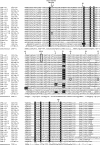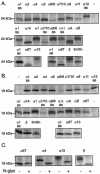Characterization of the murine alpha interferon gene family
- PMID: 15254193
- PMCID: PMC446145
- DOI: 10.1128/JVI.78.15.8219-8228.2004
Characterization of the murine alpha interferon gene family
Abstract
Mouse and human genomes carry more than a dozen genes coding for closely related alpha interferon (IFN-alpha) subtypes. IFN-alpha, as well as IFN-beta, IFN-kappa, IFN-epsilon, and limitin, are thought to bind the same receptor, raising the question of whether different IFN subtypes possess specific functions. As some confusion existed in the identity and characteristics of mouse IFN-alpha subtypes, the availability of data from the mouse genome sequence prompted us to characterize the murine IFN-alpha family. A total of 14 IFN-alpha genes were detected in the mouse genome, in addition to three IFN-alpha pseudogenes. Four IFN-alpha genes (IFN-alpha1, IFN-alpha7/10, IFN-alpha8/6, and IFN-alpha11) exhibited surprising allelic divergence between 129/Sv and C57BL/6 mice. All IFN-alpha subtypes were found to be stable at pH 2 and to exhibit antiviral activity. Interestingly, some IFN subtypes (IFN-alpha4, IFN-alpha11, IFN-alpha12, IFN-beta, and limitin) showed higher biological activity levels than others, whereas IFN-alpha7/10 exhibited lower activity. Most murine IFN-alpha turned out to be N-glycosylated. However, no correlation was found between N-glycosylation and activity. The various IFN-alpha subtypes displayed a good correlation between their antiviral and antiproliferative potencies, suggesting that IFN-alpha subtypes did not diverge primarily to acquire specific biological activities but probably evolved to acquire specific expression patterns. In L929 cells, IFN genes activated in response to poly(I*C) transfection or to viral infection were, however, similar.
Figures





References
-
- Adolf, G. R., I. Maurer-Fogy, I. Kalsner, and K. Cantell. 1990. Purification and characterization of natural human interferon omega 1. Two alternative cleavage sites for the signal peptidase. J. Biol. Chem. 265:9290-9295. - PubMed
-
- Aguet, M., M. Grobke, and P. Dreiding. 1984. Various human interferon alpha subclasses cross-react with common receptors: their binding affinities correlate with their specific biological activities. Virology 132:211-216. - PubMed
-
- Barnes, B. J., A. E. Field, and P. M. Pitha-Rowe. 2003. Virus-induced heterodimer formation between IRF-5 and IRF-7 modulates assembly of the IFNA enhanceosome in vivo and transcriptional activity of IFNA genes. J. Biol. Chem. 278:16630-16641. - PubMed
Publication types
MeSH terms
Substances
LinkOut - more resources
Full Text Sources
Other Literature Sources
Molecular Biology Databases
Research Materials

